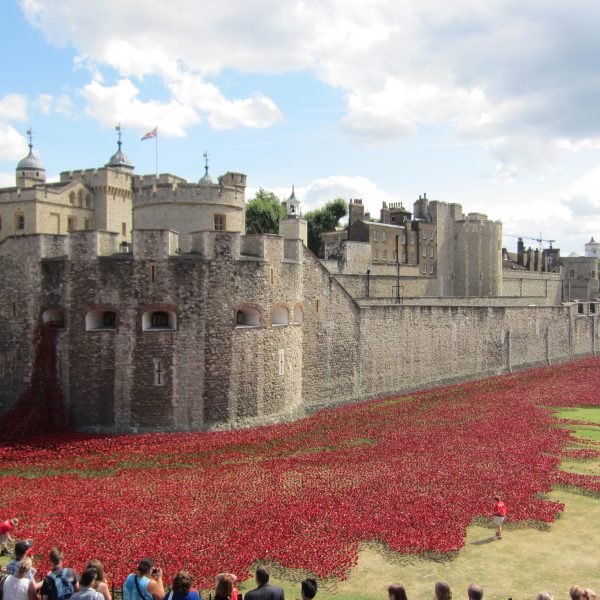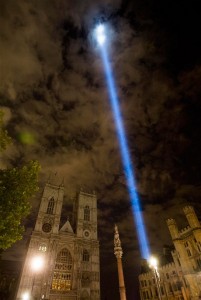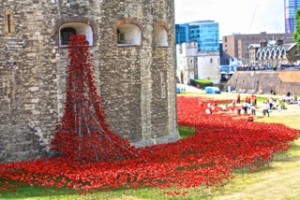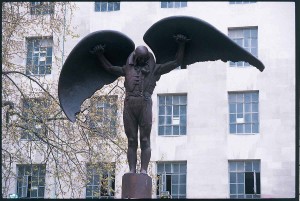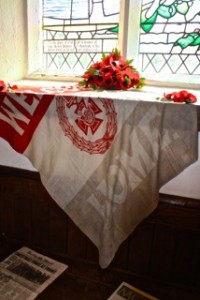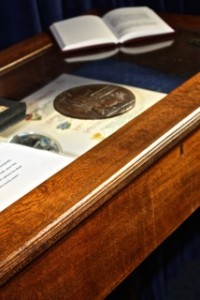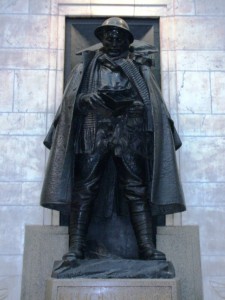2014. 100 years since the outbreak of the First World War, a devastating conflict that saw loss of life on an unprecedented scale. How does a nation commemorate such a significant event in world history whilst preserving the identity of those who lost their lives? A number of artistic projects have been undertaken to mark the centenary, often with stunning and poignant results.
Spectra
On 4th August this year a beam of white light was cast up into the night sky above London to commemorate the beginning of the First World War. Emanating from Victoria Tower Gardens, next to the Houses of Parliament, 49 powerful spotlights recalled the searchlights used during the urban blackouts. Visitors were allowed to wander amongst the beams, awestruck by the columns of light, – Ryoji Ikeda, the Japanese artist behind the concept describes how ‘from a distance it looks monumental and solid, but when you are in it, it is entirely meditative.’
Read more here: http://www.theguardian.com/artanddesign/2014/aug/05/ryoji-ikeda-spectra-first-world-war-artangel
Blood Swept Lands and Sea of Red
This vast installation at the Tower of London is one of the most widely discussed visual memorials of the First World War. Over the past few months, volunteers have been planting ceramic poppies in around the tower, and on the November 11th the final poppy will be laid – a total of 866,264 – one for each British or Commonwealth soldier killed during the First World War. Each represents ‘a single drop in an ocean of blood’.
The title of the memorial comes from a will of an unknown soldier from Derbyshire, who penned the lines ‘The blood-swept lands and seas of red, where angels fear to tread.’
The spectacle can be observed from various vantage points around the Tower, but some of the most captivating are the aerial views taken from above.
Read more here: http://www.telegraph.co.uk/history/world-war-one/11190444/Poppy-Appeal-A-sea-of-humanity-sweeps-to-the-Tower-of-London.html
Find out more here: http://poppies.hrp.org.uk
War Memorials
The government has set aside £5 million to repair war memorials throughout the country between 2014 and 2018. As Armistice Day approaches this is an ideal time to visit some of the most unusual and moving memorials that give insight into the multi-faceted scale of war.
See, for example, the Animals in War memorial on the edge of Hyde Park commemorating the suffering and loss of animal life – over 8 million horses were killed in the war, as well as thousands of mules, donkeys, dogs and carrier pigeons.
The Fleet Air Arm Memorial in the Victoria Embankment Gardens commemorates naval pilots who served in the First World War. Over 6000 men died, many of whom were lost at sea so have no physical graves. The statue is named Dedalus, a reference to the Greek myth of Dedalus and his son Icarus, who fell to his death in the ocean
after flying to close to the sun. The pose of the pilot recalls that of the Crucifixion, muscles taught and downcast gaze – whilst the enveloping wings offer a sense of protection to the viewer below.
Search the Imperial War Memorials Archive here: http://www.ukniwm.org.uk/server/show/nav.002
Read about different memorials around the capital here: http://www.secret-london.co.uk/War_Memorials.html
Living Memorials
 Living memorials have been created across the country. In the Pentland Hills near Edinburgh, Scottish soldiers are being honored with over 50,000 trees, extending a native woodland that is currently used for army training by the British forces.
Living memorials have been created across the country. In the Pentland Hills near Edinburgh, Scottish soldiers are being honored with over 50,000 trees, extending a native woodland that is currently used for army training by the British forces.
Read more here: https://www.gov.uk/government/news/living-memorial-for-scotlands-first-world-war-heroes
Similarly, at the National Memorial Arboretum in Staffordshire, the general public have been invited to partake in the planting of 15,000 bluebell bulbs in the woodland, referencing the bluebells native to the Somme, where thousands of British and German soldiers are buried.
http://www.thenma.org.uk/events/events-calendar/calendar-of-events/the-great-bulb-plant-october/
Local Memorials
On a local level, communities have been remembering those from their families and parishes who were involved in the war. At a recent flower festival at Brenchley church in Kent, one contributor chose to theme their work around the war. Flags from 1918 to welcome troops home were laid across benches, parts of uniforms were displayed, and a bronze medal – an example of those issued to a family naming their lost relation.
Letter to an Unknown Soldier
A collaborative project that invited members of the public to write a letter to an unknown soldier, inspired by the statue of a young soldier reading a letter at Paddington Station. All the letters that were submitted can be read on the website. Over 21439 were collected.
Read the letters here: http://www.1418now.org.uk/letter/
This list is covers only a tiny fraction of the ways the First World War, and those who have lost their lives, have and continue to be remembered by subsequent generations.
Find out more here: https://www.gov.uk/government/topical-events/first-world-war-centenary
(photos courtesy of Fiona Grant and Google Images)


